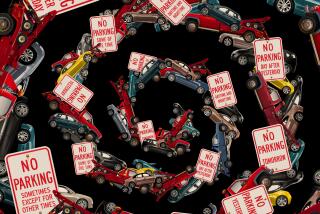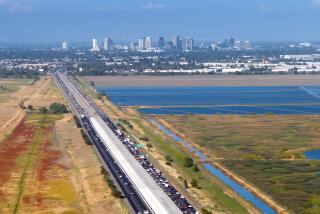Driving for dollars
CALTRANS’ crusade to add more carpool lanes to Southern California freeways continues unabated; too bad the department doesn’t know how many real carpools use them. Unless the department can show that the high-occupancy-vehicle lanes are actually reducing the number of cars on the road, its multibillion-dollar plan to add hundreds of miles of new HOV capacity around Los Angeles will be a colossal waste of taxpayers’ money.
The only vehicles that deserve the label “carpools” are those in which at least one occupant would otherwise be driving his own car but for the carpool. Everyone else is getting a windfall.
Most emphatically not in the real carpool category is a mother driving her 11-year-old daughter to batting practice. Yet that car gets to escape the congested regular lanes as legitimately as a pair of employees who have sacrificed some convenience to commute to work in one car instead of two. Even if a family car exclusively contains driving-age occupants — a husband and wife going to a party, for example — it is still unlikely that they would be traveling in separate cars. Other free riders in the HOV corridor include limos with a client in the back seat, commercial vehicles with two employees in the front cab and one-shot groupings of friends or neighbors who would have paired up regardless of the road configuration.
Southern California’s transportation authorities don’t know how much real carpool traffic — commuters sharing a ride — the HOV lanes attract. The chances are, however, that the amount is negligible. Nationally, the commuter carpool has “functionally disappeared,” said Alan Pisarski, a transportation consultant and author of “Commuting in America.” Eighty percent of putative “carpools” consist of family members who would likely be traveling together anyway. Data on how many potential commuter carpools were formed by computer matching is meaningless because no one is tracking how many such carpools were created and have held together.
Caltrans and Los Angeles County’s Metropolitan Transportation Authority should discard their faith-based carpool crusade and replace it with something verifiable and effective. They could reward real carpools and allocate road space more rationally by designing the intended new Southern California HOV lanes as toll roads.
Those roads would be available to anyone who pays and to employer-sponsored carpools for free. Employers would have to regularly certify that their workers’ carpools were still operating; those carpools would receive a transponder that would allow them to travel gratis on the toll roads, as the Reason Foundation’s Robert Poole has suggested. Everyone else — including families — would pay for the privilege, at rates that vary with congestion. The net result would be fewer cars on the roads at rush hour — something that existing HOV lanes have failed to achieve.
Los Angeles County officials announced last week that they were finally dropping their opposition to toll roads, a welcome move away from the idea that driving is an entitlement. Unless Caltrans builds its new Southern California lanes as toll roads with the ability to certify actual carpools, the department would be better off allowing all cars to use the planned new lanes. Setting them aside as free corridors for the lucky few who just happen to have more than one occupant in their car is a useless policy.
More to Read
Sign up for Essential California
The most important California stories and recommendations in your inbox every morning.
You may occasionally receive promotional content from the Los Angeles Times.










